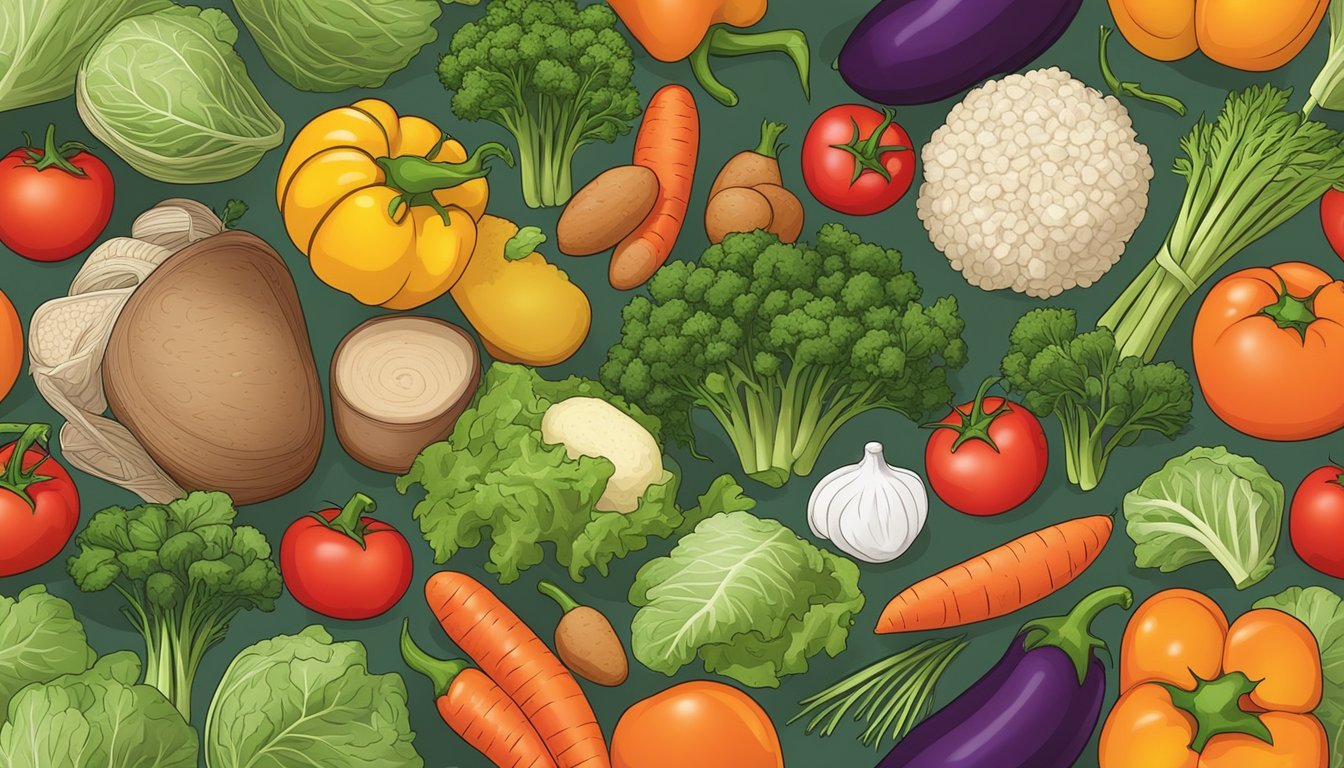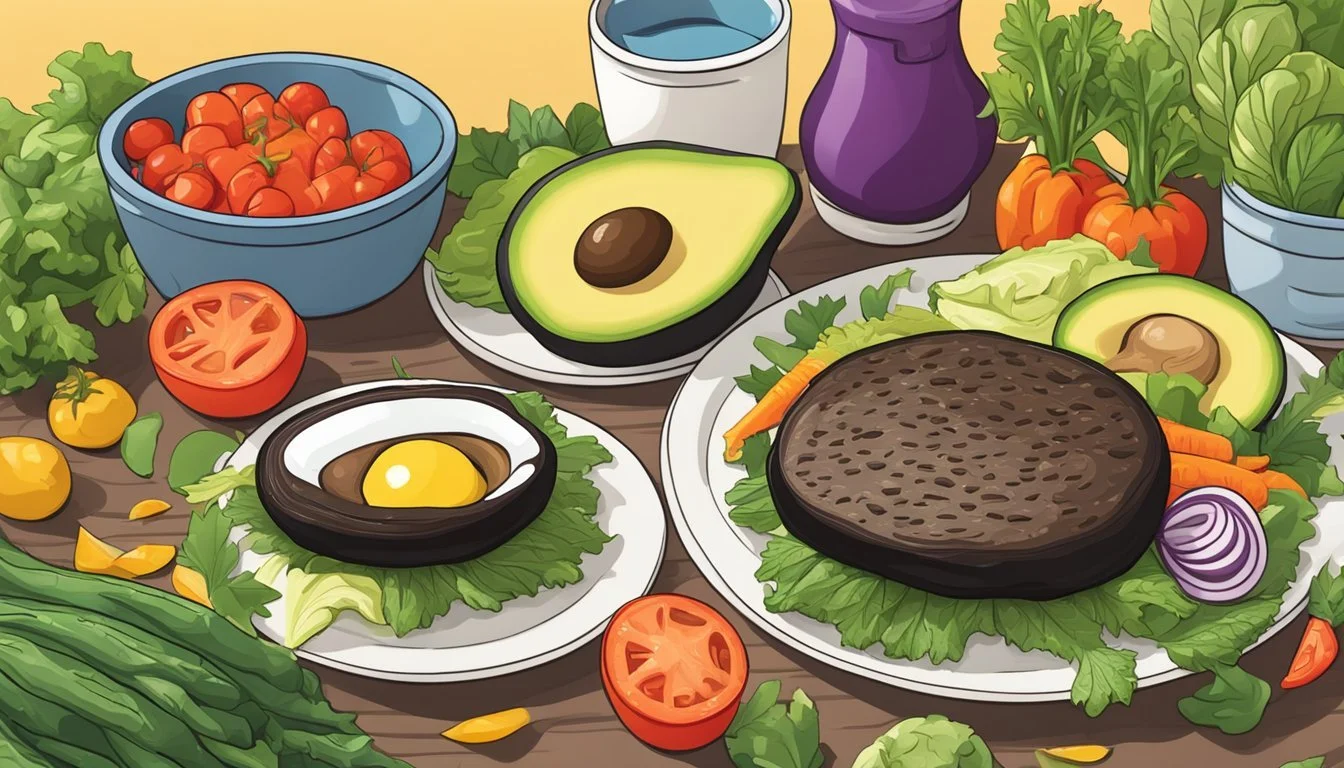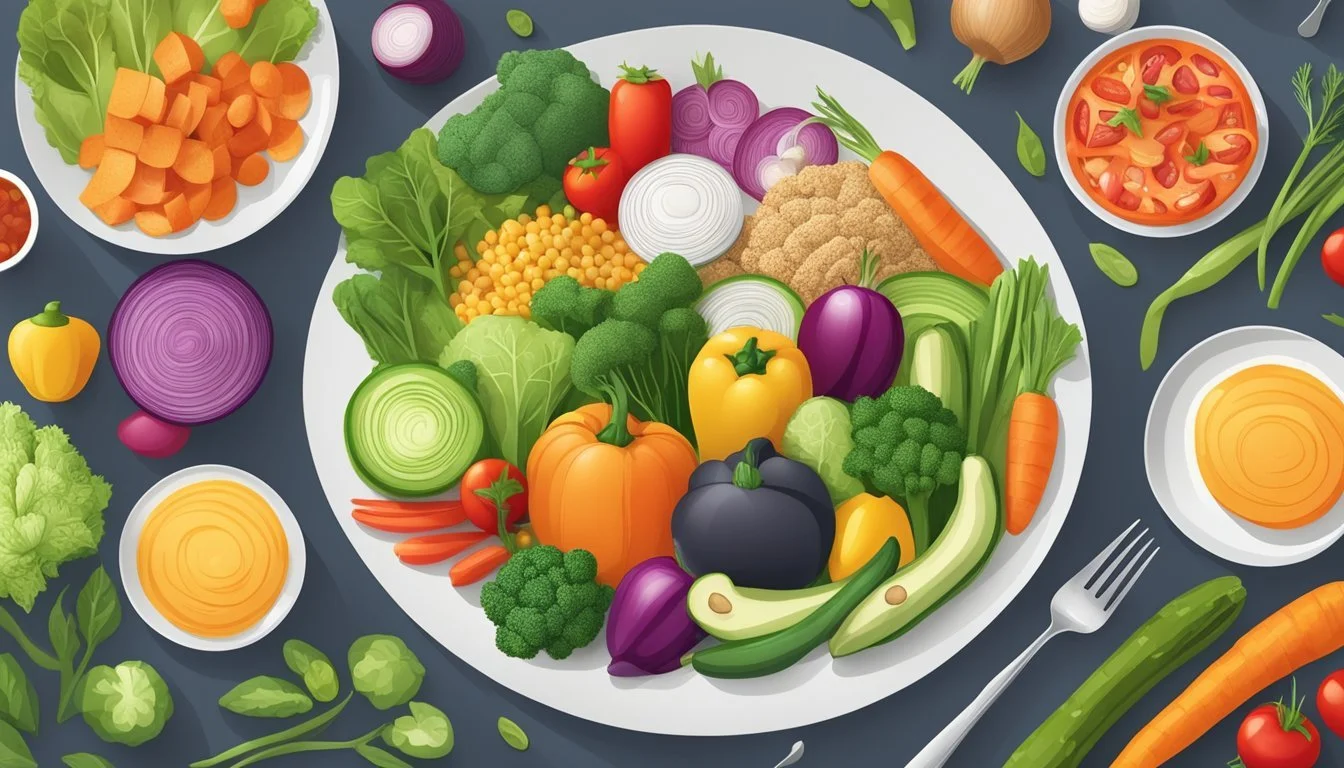7 Veggie-Packed Meals Perfect for Diabetics
Nutritious and Flavorful Options
Managing diabetes through diet can be straightforward and enjoyable, particularly when focusing on nutrient-rich vegetarian meals. Plant-based dishes naturally support stable blood sugar levels, providing vital nutrients without the added concern of saturated fats found in some animal products. Incorporating varied and delicious vegetarian options into one's diet can greatly benefit those with diabetes.
A well-planned vegetarian diet offers an array of health advantages, especially for individuals seeking to manage their blood sugar. With the right ingredients, diabetic-friendly vegetarian meals can be both satisfying and nutritious. These meals can help maintain balanced glucose levels and promote overall well-being for those with diabetes.
1) Quinoa-Stuffed Bell Peppers
Quinoa-stuffed bell peppers are a vibrant, nutritious option for diabetics. These peppers are not only rich in flavor but also packed with fiber, vitamins, and minerals.
Start by preheating the oven to 350 degrees Fahrenheit. Cut the tops off the bell peppers and remove the seeds and membranes.
Cook quinoa according to package instructions. In a large bowl, mix the cooked quinoa with ingredients like black beans, corn, diced tomatoes, and onions. Season with garlic, cumin, and chili powder for a savory touch.
Fill each bell pepper cavity with the quinoa mixture. Place the stuffed peppers in a greased baking dish, cut sides up.
Bake in the preheated oven for about 30 minutes or until the peppers are tender. This dish is an excellent choice for a diabetic-friendly meal that is both simple and delicious.
2) Roasted Cauliflower Steaks with Tahini Sauce
Roasted cauliflower steaks with tahini sauce are a flavorful and nutritious option for diabetics. To prepare, preheat the oven to 400°F (205°C).
Slice the cauliflower into one-inch thick steaks, ensuring the head remains intact. This technique maintains the structure of the steaks for roasting.
Arrange the cauliflower steaks on a baking sheet lined with parchment paper. Brush both sides with a mixture of olive oil, paprika, garlic powder, salt, and pepper.
Roast the steaks in the preheated oven for 25-30 minutes, or until they turn golden brown and tender. This process enhances the natural sweetness and nutty flavor of the cauliflower.
While the steaks roast, prepare a tahini sauce. Mix tahini, lemon juice, water, and minced garlic in a bowl until smooth. Adjust the thickness with more water, if necessary.
Once the cauliflower steaks are roasted, drizzle the tahini sauce generously over the top. This sauce adds a creamy, nutty flavor that complements the roasted cauliflower.
This dish is not only tasty but also offers a variety of nutrients without spiking blood sugar levels, making it an excellent choice for those managing diabetes.
3) Zucchini Noodles with Pesto
Zucchini noodles, often referred to as "zoodles," are a low-carb alternative to traditional pasta. They provide a crisp texture and hold up well with various sauces, including pesto.
To prepare this dish, start by spiralizing fresh zucchini into noodles. This can be easily done using a spiralizer.
Next, pat the zucchini noodles dry with a clean paper towel to remove excess moisture. This step ensures the noodles won't become too watery when cooked.
Heat a bit of olive oil in a large skillet. Add the zucchini noodles and sauté for 2-4 minutes. Be careful not to overcook them to maintain their crunchy texture.
Once the noodles are ready, toss them with freshly made basil pesto. The combination of basil, garlic, nuts, and olive oil in the pesto pairs perfectly with the mild flavor of the zucchini.
Optionally, add cherry tomatoes for a splash of color and extra nutrients. Some may also enjoy a sprinkle of vegan parmesan cheese on top.
These zucchini noodles with pesto make a nutritious meal. They are especially suitable for diabetics due to their low carbohydrate content.
4) Sweet Potato Black Bean Chili
Sweet Potato Black Bean Chili offers a nutritious and flavorful option. It combines sweet potatoes and black beans, both rich in fiber and complex carbohydrates, essential for managing blood sugar levels.
To prepare this chili, start by peeling and dicing sweet potatoes into 1-inch cubes. Cook these with diced onions and garlic in a pot with a bit of olive oil.
Once the vegetables are tender, add canned tomatoes, black beans, and vegetable broth. Let the mixture simmer until the sweet potatoes are soft and the flavors meld together.
For seasoning, use chili powder, cumin, and smoked paprika. These spices enhance the flavor without adding unnecessary sugars or fats. Adjust salt and pepper to taste.
Serve the chili hot, optionally garnished with fresh cilantro or a squeeze of lime juice. It's a dish that's hearty, healthy, and perfectly aligned with a diabetic-friendly diet.
5) Lentil and Spinach Salad
Lentil and spinach salad makes for a nourishing and delicious option suitable for diabetics. Rich in plant-based protein from lentils and packed with essential vitamins from spinach, this salad offers a well-rounded nutritional profile.
Start by cooking lentils until tender, allowing them to cool to room temperature. Combine the cooked lentils with fresh spinach in a large bowl.
Add a variety of vegetables like red onion and cucumber to the mix. Incorporate feta cheese and parsley for added flavor.
Prepare a simple dressing by whisking together olive oil, lemon juice, kosher salt, and black pepper. Pour the dressing over the salad and mix well.
For an extra touch, add ingredients like raisins, candied walnuts, and cheddar cubes sparingly. This combination not only enhances the taste but also provides additional nutrients.
Serve this salad either warm or chilled. It can also be garnished with extra feta cheese if desired. This dish combines ease of preparation with robust flavors, making it a practical choice for maintaining a balanced diet.
6) Chickpea and Vegetable Stir-Fry
Chickpea and Vegetable Stir-Fry is a nutritious and flavorful option for diabetics. It's a great dish packed with fiber and protein, thanks to the chickpeas, which help maintain steady blood sugar levels.
Begin by heating sesame oil in a large skillet over medium-high heat. Add onions and garlic, stir-frying for 2-3 minutes until they become fragrant.
Next, add mixed vegetables such as broccoli, carrots, bell peppers, and snap peas. Cook for 5-7 minutes until the vegetables are tender-crisp.
Add cooked chickpeas along with soy sauce and a touch of maple syrup for flavor. Stir-fry everything together for another 2-3 minutes until well combined.
This dish is best served over cooked brown rice or quinoa. Both options offer additional fiber, making it a well-balanced meal suitable for diabetics.
With its mix of vegetables and legumes, Chickpea and Vegetable Stir-Fry is not only delicious but also supports healthy eating habits.
7) Grilled Portobello Mushrooms with Avocado
Grilled portobello mushrooms paired with creamy avocado make for a hearty and nutritious dish.
Start by cleaning the mushrooms and removing their stems. Pierce the caps with a fork to help absorb the marinade.
Prepare a marinade using olive oil, balsamic vinegar, garlic, and some herbs like oregano. Coat the mushrooms well and let them sit for 30 to 60 minutes.
Preheat the grill to medium-high heat, about 350 to 400 degrees Fahrenheit. Brush the grates with oil to prevent sticking. Grill the mushrooms for 3-4 minutes on each side until they are caramelized and deep golden brown.
While the mushrooms are grilling, slice a ripe avocado. Once the mushrooms are done, place the avocado slices on top.
A sprinkle of salt and a squeeze of lemon juice enhances the flavors. This simple yet flavorful combination provides a satisfying meal loaded with healthy fats and fiber, which are beneficial for diabetics.
Nutritional Benefits of Vegetables for Diabetics
Vegetables play a vital role in diabetes management due to their rich fiber content and low glycemic index, which help in maintaining blood sugar levels and promoting overall health.
Rich in Fiber
Fiber is essential in a diabetic's diet. It aids in slowing down digestion and the absorption of carbohydrates.
This process helps to prevent spikes in blood sugar.
Soluble fiber, in particular, can help control blood sugar levels.
For instance, consuming high-fiber vegetables like carrots and cabbage can make meals more satisfying.
This minimizes the risk of overeating and helps manage weight.
Arugula and rocket are other fiber-rich options that add not only nutrients but also flavor to meals.
A higher intake of fiber can also improve digestive health, which is often a concern for diabetics.
Low Glycemic Index
Low glycemic index (GI) vegetables are beneficial for diabetics because they lead to slower increases in blood sugar.
Cabbage is a prime example, providing both a low GI and digestive benefits.
Consuming low GI vegetables like cabbage or carrots, when eaten in moderation, can help maintain more stable blood glucose levels.
Vegetables such as arugula are particularly good in salads or as add-ons to main dishes.
Incorporating a variety of low GI vegetables into daily meals offers a sustainable approach to blood sugar management.
Managing Carbohydrate Intake
To effectively manage diabetes, it is crucial to control carbohydrate intake. This involves accurately counting carbohydrates and balancing meals to avoid blood sugar spikes.
Understanding Carb Counting
Carb counting is essential for diabetics to maintain stable blood glucose levels. Carbohydrates convert to glucose in the body, affecting blood sugar.
Examples of carb-heavy foods include:
Fruits and juices
Grains and cereals
Starchy vegetables like potatoes and corn
Legumes and beans
A common method involves measuring the grams of carbohydrates per meal. A typical target might be 45-60 grams per meal for women and 60-75 grams for men, but individual needs vary, and consulting a nutritionist is advised.
Balancing Meals
Balancing meals for diabetics means combining carbohydrates with proteins, fats, and fiber-rich vegetables. This combination helps slow glucose absorption, preventing spikes.
Key elements to balance a meal:
Lean proteins: eggs, tofu, tempeh
Healthy fats: avocados, nuts, seeds
Fiber-rich vegetables: leafy greens, broccoli, bell peppers
Using a method like the plate method can simplify this process. Fill half the plate with non-starchy vegetables, a quarter with protein, and the last quarter with carbohydrate foods. Adding healthy fats like olive oil can further slow glucose absorption.
Incorporating Veggies into Your Diet
Integrating vegetables into your daily meals can boost overall health and manage blood sugar levels effectively. Learn about various cooking methods and meal preparation strategies to include more veggies in your diet.
Creative Cooking Methods
Experiment with different cooking techniques to make vegetables more appealing. Roasting brings out the natural sweetness of veggies like carrots, bell peppers, and zucchini. Simply toss them with olive oil, salt, and your favorite herbs before placing them in the oven.
Steaming preserves the nutrients in vegetables while keeping them tender. Steamed broccoli, green beans, and spinach can be seasoned with lemon juice and a bit of garlic for added flavor.
Incorporate veggies into everyday meals by blending spinach into smoothies or adding shredded carrots and zucchini to muffins and pancakes. Grilling is another excellent method, particularly for hearty vegetables like portobello mushrooms, eggplant, and peppers.
Stir-frying vegetables such as bell peppers, snow peas, and onions in a wok with a small amount of oil can create a quick, nutrient-dense dish. Boiling can be employed minimally as it may lead to nutrient loss, but it works well for making veggie-based soups and broths.
Meal Prep Tips
Start your week by planning and prepping your veggie meals. Chop and store vegetables in airtight containers to streamline your cooking process for the week.
Use meal prep time to prepare larger batches of veggie-packed dishes like stir-fries, salads, and soups. This way, you always have healthy meals ready to go. Composite meals such as casseroles and one-pot dishes can pack various veggies together, making them a convenient option.
Store pre-washed and cut vegetables in the fridge for easy access. This makes adding them to your meals effortless. Freezing is another good option. Freeze chopped veggies in portions to use in future recipes.
Consider making veggie-based snacks like carrot sticks, cucumber slices, and bell pepper strips, paired with hummus. This is an easy way to increase vegetable intake throughout the day.







